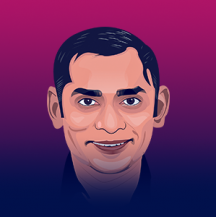Febin John James's Blog, page 2
February 27, 2023
Beyond Scripted Responses: How ChatGPT can Elevate Chatbots to be More Human-like

Chatbots huh?

You are unlikely to be an alien to the above experience.
Can ChatGPT tech make an impact?
Let me begin with a disclaimer; tech in itself can’t solve problems without intent. People utilising GPT must have the intention to understand the customer and have a heart ❤️ to help them (like us 😊).
Let’s start with some basic understanding.
Melinda: A designer in Missouri who’s trying to file her taxes.
Dora: A chatbot without GPT capabilities.
Tars: A chatbot with GPT capabilities.
Melinda asks “Will my taxes be discharged in my bankruptcy?”
Understanding Melinda’s problemBefore GPT, mapping anything Melinda typed into the scripted workflow was tricky.
One solution is to provide a limited set of options and allow the user to choose from them.



But then there’s a limit of buttons you can put in the small box. Melinda could type anything.
Another solution was to use a solution like Google Dialog Flow, train it with questions and answers, and hope you get lucky.

“Will my taxes be discharged in my bankruptcy?”
The luck factor depends on the keywords used by Melinda. If she uses the word “eliminated” instead of the trained word “discharged,” you are out of luck.
You can imagine the work the department has to put in to make this work. Manually type all possible ways of questions Melinda can ask the question, including all likely slang, typos, etc.
Can GPT make an Impact?Yes, it can make a drastic difference.



Melinda asks, “Do I get a relief on taxes if I am broke?”
And our bot has responded with, “We offer payment plan options and waivers of penalties and interest for taxpayers experiencing financial hardship.”
The answer is cool and scripted because it’s extracted from a knowledge base, but Melinda isn’t assured enough. So she asks something along the lines of, “Can you give an example?”
Now here’s where the magic happens!
“Let’s take John, a Missouri resident has recently lost his job. He owes $5,000 in state income taxes, but he doesn’t have the money to pay the amount by the deadline.
John can request a payment plan, which would allow him to pay off his tax debt over time in installments. This would help him avoid any penalties or interest charges that might accrue if he failed to pay the full amount on time.
Alternatively, if John is unable to make any payments at all, he may be able to request a reduction in the amount of taxes owed, such as a waiver of penalties and interest. To do this, he would need to demonstrate that he is experiencing financial hardship and is unable to pay his taxes due to circumstances beyond his control, such as a job loss or a medical emergency.”
This answer wasn’t scripted; GPT generated an example on the fly to make Melinda understand!
Let’s assume Melinda’s first language is Spanish, and she’s struggling to read through english and asks, “¿Puedes explicar en español?”
“Tomemos el ejemplo de John, un residente de Missouri, que recientemente perdió su trabajo. Él debe $5,000 en impuestos estatales sobre los ingresos, pero no tiene el dinero para pagar el monto antes de la fecha límite...”
“ChatGPT tech doesn’t just go beyond a script, it also have the excellent ability give personalised explanations for your customers.”What if the information is not present?
GPT can realise when it doesn’t have enough information, but it can’t write an email when the information is available, as in the above screenshot. That’s where our tech compliments GPT to make this experience happen.
Presently, most chatbots can make a drastic difference in customer experience using GPT Tech. In this article, I am barely scratching the surface of the possibilities of GPT.
I will be following this up with a series of articles on how it can make a huge impact. Ensure you follow me so you won’t miss out on it.
If you need help leveraging GPT into your offering, please feel free to reach out to me.
[image error]December 6, 2022
Zero Trust Explained in Simple Words
 Photo by Collin Armstrong on Unsplash
Photo by Collin Armstrong on UnsplashJust when we got enough buzzwords to wrap our heads around, yet another one?
Well yeah, it’s common sense and simple. Zero trust literally means not having faith or trust in anyone.
What?
Assume a large bank with a lot of cash and other value reserves, Trust Inc. They hired Mark to head the marketing division. Now Mark can access any bank zone with his ID card; he can walk into a room full of safe deposits and access any locker or the physical cash reserve.
That’s stupid.
Yeah, exactly. Unfortunately, a lot of online systems work this way. People provide their credentials once to join a private network online, trust is assumed, and anything is accessible.
I see, so how do I implement zero trust?
How would you go about making Trust Inc Bank secure?
1. Restrict employees to certain zones based on their role in the bank.
2. Put guards in front of critical zones like cash reserves, data centres, etc.
3. Guards would be asked to verify every employee’s access strictly (Ex: The photo on the ID card should match the appearance of the employee)
4. Build monitoring systems to detect suspicious behaviour among employees.
Yes, you see, that’s common sense. Now here’s how we would employ them in a digital system.
1. Each user (human) and service (code) are identified and given specific access or clearance levels.
2. As users or services seek access, their clearance level is checked; only if they have the necessary authorization is access granted.
3. Along with a password, Multi-Factor Authentication must be used.
4. Monitoring the behaviour of users or services to identify threats.
That’s the simplified version of how Zero-Trust can be implemented.
[image error]March 13, 2022
How I created a UI/UX team in a SaaS startup without any background in design
The calling to venture into design.

I had previously published this on my personal blog .
The CallingI felt it first when I introduced our product to Anand. Though I was proud of the work I do at Tars, I wasn’t so happy about its looks. I had worked with Anand earlier in building products; even though our product failed to deliver value, it was aesthetically pleasing.
As an engineer, I could see myself creating value in Tars by building the future of conversational interfaces. But it got to a point where I started disliking javascript. Unavoidable boilerplate code I have to write repeatedly. Work got repetitive, and programming isn’t fun anymore.
Our startup is bootstrapped and profitable since we took the interface route instead of pursuing the AI/ML hype. As our customers matured, there was no end to future requests. Most of them were great features that could save people time, effort and money. But they remained in words, moving from Google Docs to Jira to Notion.
Some of which got implemented after a lot of effort and time. Though it was functional, the experience got sacrificed for deliverability. Building software takes time, and I honestly started losing patience since my dream product seemed far away.
One evening as I was writing code to optimize WhatsApp Campaigns, I had a realization. I took a cab to Vinit’s place, and told him “I can’t do this anymore”. During the conversation, he told me “Why don’t you start a design team in this company?”
The ProcessMy heart started racing faster, life started to get exciting. We started small by taking part of the product and incrementally revamping it. It took us two weeks to hire interns. Sameer’s design stood out, and Priyamwada’s design case study was top-notch among 100s of applicants.
Though I had conducted design thinking workshops in my early 20s, they were not related to visual or UX design. It was more about empathizing with the user’s problem and finding affordable solutions. Later presenting the solution, taking feedback and improving the solution iteratively.
I set up a similar process here.
Conduct interviews with customer success teamIdentify and prioritize pain pointsCompetitive researchPrototypePresent & Take FeedbackIterateFollowing the process is not the difficult part. You might end up making things cool but it need not work. It’s easy for us to get lost on thing that don’t even matter while being blind spotted to obvious and neccessary concerns.
Good design is more than making things look cool. It’s about building interfaces that are not ambiguous, providing actionable insights and empowering your customers to explore the product to its fullest. Such interfaces can be built only when the design team can empathize with the perspectives of different kinds of people.
Our customer success team significantly contributed to identifying interface barriers between the product and the user.
Ish brought a different perspective altogether. His common questions includes: “Why?”, “But, what do I do with it?”, “This part is not clear. Does it do this or does it do that?”.
Vinit understood the suitable threshold of elements that can go in the interface and get too overwhelming.
I made my team understand multiple perspectives, clarifyed intentions and explained technical jargons. Vinit also contributed to this. Slowly I could see Sameer and Priyamwada becoming more independent. My next focus is identifying common patterns in perspective and making them part of the design review process. Hence reducing the feedback loop and design rework.
ResultsWhatsApp Campaigns Before

WhatsApp Campaigns Now (Some parts like main nav yet to be revamped).


Nothing was more exciting than to see our engineering team ship user flow analytics.

And here’s a preview of what’s coming.

Shipping things out on a deadline isn’t easy. Emmanual and Ankit significantly contributed to implementing the design without compromising the quality.
ButYes, to the question, how can someone pull that off without experience in design?
Well, it’s less about me and more about an environment that’s set for growth.
It’s about the leaders who put faith in you when you want to do something in the company that has never been done before.
It’s about our then interns (now FTEs) who are open to constructive feedback and has the curiosity to learn things.
It’s about our colleagues who genuinely want the product to make our customers successful.
We are hiring good people, join us.
[image error]March 7, 2020
Human-Machine Communications & Singularity
Arthur was such a visionary. His predictions on the future of human to human communications was right on spot. It will continue to improve with the help of technology.
The universal language translator wearable from Star Trek that can translate any language live is not far away (Excluding alien languages, if they exist). There could be a couple of startups into something similar already.
https://medium.com/media/0de321eff851822b0d697492d6d35216/hrefHowever, there’s something more fascinating, human-machines communications.
As effective communication is indispensable for humans to work with each other, so is true for us to collaborate with machines. We are yet to tap into the true potential of machines.
There are two parts to human-machine communications.
Machines understanding humans.Machines communicating back to us.In the last decade, we were able to apply deep learning technology to make machines understand human language or data generated by humans for specific cases. By the end of this decade, we might be able to see this for generic cases. That would be a remarkable achievement.

Machines communicating back to us is in its early beta. One of the examples is This Person Does Not Exist. Here, an engine can generate photo-realistic faces with provided parameters. Again, this will mature by the end of this decade.

Once we solve the two parts mentioned above, humans and machines will be able to work effectively.
We would be able to see the following changes.
Scientific discoveries will accelerate exponentially. (This will lead to singularity).A lot of menial work humans do will be eradicated.There won’t be human assistants anymore.The time taken for an idea to materialize will drastically reduce.A couple of our coworkers will be robots.https://medium.com/media/fd2f440c4650643d08708c9730893b51/hrefMy view of singularity is a time when quantum physics, quantum biology, quantum chemistry and quantum computing converging at a single point. We would be living in a drastically different world. These are my imaginations of how it could be.
There would be machines that can convert energy into food or objects. Food/Weapon replicator from Star Trek or the Akshaya Patra from Mahabharat would be a reality.https://medium.com/media/69d98c1a2688e94f36b52da573dc6377/href2. Instead of going to a doctor, humans will connect to a port in a machine to scan and fix a virus.
3. Humans will have machine organs that can support longevity. We might also see biological transfusion of humans and machines.
https://medium.com/media/df50ba7553fdefdb7573e08d4372e98c/href4. We might have different versions of humans and animals through gene editing.
5. We won’t be able to differentiate between virtual reality and reality (Inception).
And the list goes on…
If I have to make a guess, I think these will occur somewhere between the years. 2035–2050. (Provided there are no wars and environmental catastrophes).
[image error]May 20, 2019
Orrin Cross I have a doubt.
Orrin Cross I have a doubt. How do you guys keep the activity recognition listener running ? Once you subscribe for updates with a context, I assume android OS after oreo kills the service/activity which subscribes of updates?
How do you guys keep it running?

April 10, 2019
April 1, 2019
November 16, 2018
A Beginner’s guide to Proof of Authority
 Introduction to Consensus
Introduction to ConsensusIn decentralised systems, confirming transactions becomes tricky. The challenge is that the power of confirming a transaction shouldn’t lie in the hands of a single entity. There were several attempts to solve this challenge. The mechanism to confirm these transactions in a decentralised manner is referred to as consensus.
Proof of WorkIn the beginning, we started with the proof-of-work consensus mechanism. Here, the entity confirming a transaction needs to solve a mathematical problem in order to validate transactions. Hence, every entity in the decentralised network has equal opportunities to validate transactions as long as they make adequate investments in mining resources.
However, this brought a new problem. The proof-of-work consensus mechanism turned out costly. It has been estimated that by 2020, the first system which implemented this mechanism needs the same energy that is required to power the entire United States.
Proof of StakeSince the cost was too high, innovators brought in the proof-of-stake mechanism. Here the entity validating transactions needs to put their money at stake. If they behave maliciously they will lose their staked money. Though is was cost-effective, there is still the question: do we achieve true decentralisation?
The minimum amount of investment required to participate in the popular proof-of-stake system is around 1250 ETH (~$220k on 16/11/2018). Hence the power to become a participant in this mechanism is only for the wealthy. They are small in number, hence the power of validation lies in the hands of a few.
Proof of AuthorityThis problem forced us to innovate and bring in a new consensus mechanism: proof of authority. This mechanism is carried out through three algorithms.
Algorithm 1: Approval of the list of validating nodes
In proof of authority, one doesn’t have to spend excessive energy or need to be wealthy to confirm transactions. However, they need to register into the network and win the votes of existing entities. If the entity behaves maliciously they can be voted out.
Algorithm 2: Determining the right of the entity to confirm the next block of transactions
Here unlike the previous mechanism, the entities participating in the consensus should confirm transactions within a limited period of time. They perform this operation by sequentially validating transactions and confirming their validity through execution. Later it signs these transactions and send them to the network. Once the network receives them, it performs a check to see if the entity has the right to confirm the block of transactions in the specified interval. Since the confirmation of new blocks occurs at a specified time interval, the throughput of this mechanism is drastically higher.
Algorithm 3: Confirmation of transaction validity
In the blockchain ledger, we have a list of confirmed transactions. Now, when the new set of transactions are received, the validating entities can execute these transactions on the confirmed ledger. These transactions are sequentially executed.
Hence every validating entity should reach the same conclusion in the ledger and reach a consensus. In case of discrepancies, the length of individual chains are taken and the longest chain becomes the winner. The other entities whose chain was not accepted will roll back and work over their blocks.
SummaryThe consensus is a mechanism in the blockchain to validate a set of transactions. It’s important for the consensus mechanism to be carried out in a decentralised manner because if the power of confirming transaction lies with a single entity, it can be abused.
Though proof of work mechanism was a great innovation, it consumed a ridiculous amount of energy. The proof of stake mechanism which addressed the energy problem brought a new risk of validation being in the hands of wealthy entities.
Hence proof of authority was conceived, where the validating entities are selected through a voting process. They need to validate transactions through execution and reach a consensus for the blocks of the transaction to be confirmed. They provide better decentralization and higher throughput of confirmed transactions when compared with other mechanisms.

Febin John James is one of the top writers in Innovation and Technology on Medium. He writes for publications like Hackernoon, FreeCodeCamp, etc.

Blockchain Business Review from Apla provides high-quality educational material from the world of blockchain to inform the business community of the competitive advantage that can be gained by integrating distributed ledger data storage within organizations. Our mission is to promote knowledge about blockchain and its uses in both the private and public sector and demonstrate the value of blockchain integration.

A Beginner’s guide to Proof of Authority was originally published in Apla on Medium, where people are continuing the conversation by highlighting and responding to this story.
November 2, 2018
7 Rising Leaders in the Crypto Industry You Need to Know

The software and internet revolution was led by leaders like Steve Jobs, Bill Gates, Elon Musk, and the likes. They gave us things that were far beyond our imagination. Now, in the crypto revolution, we see new leaders who have fearlessly set goals to build the impossible. Let’s find out who they are and the change that they are fuelling.
David Siegel (The Pillar Project) Credits : United Conference of Internet & Money
Credits : United Conference of Internet & MoneyDavid Siegel is an entrepreneur with a strong sense of user design. Through his Pillar Project, he is trying to give users complete control over their personal data. Our personal data which we entrusted in the hands of Facebook, Google, and even banks have been abused repeatedly over the past few decades. It was even used for psychological manipulation in the 2016 elections. David Siegel is on a mission to enforce the user’s right to privacy through his Pillar Project. The Pillar Wallet securely stores user’s personal information. You have total control of who is allowed to see which data to what extent. You can read more about their mission in their grey paper.
Sonja Prstec (Bitnation) Credits : UCIM
Credits : UCIMSonja Prstec is a lawyer who is trying to make the world borderless through her company, Bitnation. The place of our birth decides our choice of values, jurisdictions, and economic opportunities. What if we are given an option to select a community whose values resonates with ours? This is the idea behind Bitnation. They have created a blockchain jurisdiction through which you can create your own nation with your own set of rules. You can read more about their mission in their white paper.
Vishal Gupta (Diro Labs) Credits : UCIM
Credits : UCIMVishal Gupta is on a mission to fight identity theft through his company, Diro Labs. Since current KYC systems don’t check for data validity, it’s easy for someone to steal your identity. Diro Labs provides a facility to validate the facts of a document by confirming it with government databases. They also automate the due diligence process along with enabling remote authentication. You can read more about their mission in their white paper.
Babu Munagala (Zebi) Credits : UCIM
Credits : UCIMBabu Munagala is on a mission to enable a secure, seamless and consent-based exchange of highly sensitive information. Governments around the world store such information on centralized servers. There have been multiple occurrences where such sensitive information was hacked and leaked. The risk of this data being tampered is also high. Such situations can cause great difficulties for citizens around the world. Babu Munagala has built Zebi to store highly sensitive information on private blockchains. They are proven to be tamper-proof and incredibly secure. Institutions can request data of citizens from Zebi’s APIs, however, it is only revealed to them with the individual’s permission. You can read more about their mission in their white paper.
Vincent Lim (Fanfare) Credits : UCIM
Credits : UCIMVincent Lim is on a mission to empower and incentivize consumer influencers through his platform Fanfare. They believe the current trend of micro-influencers would shift to consumer influencers in the next few years. Hence consumer videos are going to have a major influence on people’s purchase decisions. However, current social networks don’t have a tight integration with e-commerce. It’s difficult to know if a consumer video on Facebook led to any conversions. Fanfare provides a platform where consumers can upload product videos. Brands can track these videos to evaluate the conversions it led to and incentivize the creator accordingly. You can read more about their mission in their white paper.
Igor Chugunov (Credits) Credits : UCIM
Credits : UCIMIgor Chugunov is on a mission to build a platform that makes smart contracts fast, cheap, and scalable. Though Ethereum was a great innovation, its contracts take time to execute. Credits drastically reduce the cost to 0.0001 USD. It claims to process millions of transactions per second. They also offer great tools for developers to simplify developing dApps on smart contracts. They also support the cyclic process, the ability to execute instructions at regular intervals. You can read more about their mission in their white paper.
Natan Avidan (ORCA Alliance) Credits : UCIM
Credits : UCIMNatan Avidan is on a mission to simplify crypto & fiat asset management. Presently, it’s difficult for newbies to get started with cryptocurrencies. Most of them lack awareness about the security practices and store their crypto holdings in centralized exchanges. Managing multiple crypto wallets and bank accounts at different places is a pain. Orca helps you manage your crypto and fiat assets with a single app. It also provides you with AI assistance to get the best out of your assets. You can read more about their mission in their white paper.
Though the internet and software revolution brought us great innovations, it also produced problems in privacy and security. Decentralized markets seem to be promising for the welfare of people around the world. We have the above leaders with a mission to fight the issues of security, economic inequality, and privacy with an overall vision to make this world a better place. United Conference of Internet & Money has invited me to cover their event in Singapore. I am curious and excited to hear from these leaders.
Claps please
September 12, 2018
How Can This Blockchain Platform Help You Earn?
 This paid story is brought to you by Fanfare
This paid story is brought to you by FanfareHave you surfed through youtube for product reviews? That’s a wise idea because they give us a realistic view of the product, unlike commercials which are hyped up and dramatic. Product reviews made by consumers are more trustworthy they even influence other consumers to buy products. If you like to make such product videos you can earn.
https://medium.com/media/4d4b94ceb1f95177e53ecd2ecdc19a40/hrefHowever, youtube is not paying producers like they used to. They also lack integration with e-commerce platforms. Since it is difficult for brands to monitor conversions.
Fanfare built a platform to help consumers and brands. Consumers would get paid to influence others to buy. Brands can get a better return for their investment because they only have to pay influencers when a sale happens.
Fanfare has already made a fully functional platform. Their product has got more than 200,000 downloads from Google Play Store and iOS App Store.

Now, they are planning to replace their centralised coin system with ERC 20 Fan Token. One of the benefits of the ERC 20 token is that they are tradable. If you have earned FAN token for promoting products, you can exchange it for other crypto assets or even fiat(ex: USD).
Blockchain will ensure all the activities in the system are recorded and available for public view. Influencers can ensure they are incentivised adequately for their work. It brings in accountability and trust into the system.
If blockchain integration works out well, platform’s maintaince cost would be minimal. Hence more money can be distributed to consumers.
Benefits for usersReceive FAN Tokens when their video is verified by a brand.Receive FAN Tokens when their video is converted into a shoppable video.Rewarded with FAN Tokens for watching videos.Purchase of products from Fanfare eStore.Vote for winning video in brand campaigns.Trade FAN Tokens on exchanges.Benefits for brandsReward content creators upon verifying and adding the video to the brand channel.Reward content creators when converting a video into a shoppable video by adding a product to it.Purchase a ticket to make an announcement to all their fans (e.g., the launch of a new campaign, new product launches, upcoming promotions, etc.).Trade FAN Tokens on exchanges.When a consumer video is verified, 50% of the reward goes directly to the video creator. The other 50% is transferred into Fanfare’s revenue pool.
20% of the revenue pool is distributed back to our active users. 30% of the FAN tokens will be given back to buyers who have purchased from their eStore as a form of cash back, thereby encouraging more purchases.
ConclusionFanfare help consumers get paid for promoting products. Unlike, other ICOs on the market, Fanfare has a fully functional product with decent traction. Once they replace their centralised coins with ERC 20 tokens, it will become tradable and hence increasing in value. Brands and users can exchange these coins for other crypto assets or even fiat(Ex: USD). By integrating blockchain they bring trust and accountability to the system. If you would like to participate in their token sale, visit here.

How Can This Blockchain Platform Help You Earn? was originally published in Hacker Noon on Medium, where people are continuing the conversation by highlighting and responding to this story.





